Research on Offshore Photovoltaic Project Site Selection Based on PRISMA: A Systematic Review
Abstract
1. Introduction
2. Materials and Methods
2.1. An Overview of the Systematic Quantitative Literature Review (SQLR) Process
2.2. Record Identification
2.3. Screening, Eligibility, and Inclusion
2.4. Data Extraction and Variable Definitions
3. Results
3.1. Overview of Papers Characteristics–Citation Metadata
3.1.1. Current Spatial and Temporal Distribution of Research
3.1.2. Bias Risk Assessment
3.2. Offshore Photovoltaic Site Selection Methods: A Critical Comparison and Suitability Assessment
3.2.1. Method Selection and Analysis
- (1)
- Based on GIS and Analytic Hierarchy Process (GIS-AHP)
- (2)
- Based on GIS and Multi-Criteria Decision-Making (MCDM) Method
- (3)
- Hybrid Fuzzy Method
- (4)
- Long-term Analysis Based on Climate Models
- (5)
- Method Based on Exclusion and Evaluation Criteria
3.2.2. Comprehensive Performance Evaluation of Site Selection Methods
3.2.3. Comparative Overview of Site Selection Methods
3.3. Site Selection Factors: Interactions, Trade-Offs, and Regional Differences
3.3.1. A Four-Dimensional Classification System for the Influencing Factors of Floating Photovoltaic (FPV) Site Selection
- (1)
- Technical Dimension
- (2)
- Economic Dimension
- (3)
- Environmental Dimension
- (4)
- Policy Dimension
| Dimension | Factor | Description | References |
|---|---|---|---|
| Technical Dimension | Solar Radiation | Annual global horizontal irradiance directly affects generation efficiency. Areas with <1400 kWh/m2 require additional PV panel area for compensation | [5,13,15,24,44,50,54] |
| Water Depth | Optimal range 5–50 m. <5 m increases ecological disturbance risks; >50 m substantially raises mooring system costs | [23,36,41,43] | |
| Wave Conditions | Annual mean wave height > 2 m necessitates reinforced floating structures, increasing CAPEX by 15–25% | [12,45,55,56] | |
| Extreme Weather | Typhoon-prone regions (e.g., Northwest Pacific) require wind-resistant designs, elevating LCOE by 8–12% | [57,58] | |
| Economic Dimension | CAPEX/OPEX | Deep-water projects (>30 m) incur CAPEX of $1.2–1.8/W, 30–50% higher than shallow water | [4,46,59] |
| Grid Connection | Each additional 10 km offshore increases connection costs by $0.03/W, with optimal distance < 20 km | [46,60] | |
| Energy Storage | Solar irradiance variability > 25% requires storage, increasing LCOE by $0.02–0.05/kWh | [33,54] | |
| O&M Technology | Anti-biofouling coatings reduce OPEX by 15% but increase initial investment by 8% | [12,14,45] | |
| Environmental Dimension | Ecologically Sensitive Areas | Overlap with protected areas increases permit rejection rates to 85% | [13,61] |
| Fishery Conflicts | Aquaculture zone overlaps require compensation ($0.5–2/m2/year), accounting for 3–8% of OPEX | [36,53] | |
| Public Acceptance | Projects < 5 km from coast face 62% opposition rates, delaying approvals | [14] | |
| Carbon Footprint | Lifecycle emissions > 50 gCO2/kWh affect green certification | [7] | |
| Policy Dimension | Maritime Approvals | Multi-department approval averages 14–28 months, 3–5× longer than onshore projects | [50,54] |
| Military Restricted Zones | Cover 12–30% of available maritime areas (e.g., South China Sea, Persian Gulf) | [5,62] | |
| Carbon Constraints | Each $10/ton carbon price increase boosts project IRR by 0.8–1.2 percentage points | [6] | |
| Transnational Agreements | Regional energy conventions reduce cross-border project risk premiums by 15–20% | [61] |
3.3.2. Analysis of Floating Photovoltaic Power Station Site Selection Factors: High-Frequency Factors and Key Factors for Scalability
- (1)
- High-Frequency Factors
- (2)
- Key factors for scalability.
3.3.3. An Analysis of Economic-Environmental Coupling from the Perspective of Interactions and Trade-Offs: A Framework for Balancing Techno-Economic Factors with Environmental and Social Considerations
- (1)
- The relative importance of site selection factors.
- (2)
- The trade-off mechanism between technological economy and environmental society
3.3.4. Regional Differences in the Site Selection of Offshore Photovoltaic Projects
4. Challenges and Recommendations for Future Works
4.1. Challenges in Data Acquisition and Model Accuracy
4.2. Optimization of Multi-Criteria Decision-Making Methods and Technological Integration
4.3. Necessity of Interdisciplinary Collaboration and Integrated Research Frameworks
5. Discussion
Supplementary Materials
Author Contributions
Funding
Institutional Review Board Statement
Informed Consent Statement
Data Availability Statement
Acknowledgments
Conflicts of Interest
References
- Sen, S.; Ganguly, S. Opportunities, barriers and issues with renewable energy development—A discussion. Renew. Sustain. Energy Rev. 2017, 69, 1170–1181. [Google Scholar] [CrossRef]
- Fan, S.; Ma, Z.; Liu, T.; Zheng, C.; Wang, H. Innovations and development trends in offshore floating photovoltaic systems: A comprehensive review. Energy Rep. 2025, 13, 1950–1958. [Google Scholar] [CrossRef]
- Rekik, S.; El Alimi, S. Optimal wind-solar site selection using a GIS-AHP based approach: A case of Tunisia. Energy Convers. Manag. X 2023, 18, 100355. [Google Scholar] [CrossRef]
- Huang, X.; Hayashi, K.; Fujii, M.; Tao, L. Optimizing site selection for wind, solar, and hydropower: A comparative analysis of resource sustainability using resources time footprint. Energy Sustain. Dev. 2025, 87, 101752. [Google Scholar] [CrossRef]
- Liu, J.; Ma, X.; Lu, C. A three-stage framework for optimal site selection of hybrid offshore wind-photovoltaic-wave-hydrogen energy system: A case study of China. Energy 2024, 313, 133723. [Google Scholar] [CrossRef]
- Wang, P.; Zhou, J.; Jin, X.; Shi, J.; Chan, N.W.; Tan, M.L.; Lin, X.; Ma, X.; Lin, X.; Zheng, K.; et al. The Impact of Offshore Photovoltaic Utilization on Resources and Environment Using Spatial Information Technology. J. Mar. Sci. Eng. 2024, 12, 837. [Google Scholar] [CrossRef]
- Zhu, X.-R.; Tian, J.-H.; Wang, Y. The impact of climate change on wind and solar photovoltaic power potential and distribution in China. Adv. Clim. Change Res. 2025, 16, 730–746. [Google Scholar] [CrossRef]
- Hauger, S.; Gudat, C.; Lieb, V.; Glaser, R. GIS-based potential analysis and agro-economic site selection for agrivoltaics using AHP in two German counties. Renew. Energy 2025, 247, 123039. [Google Scholar] [CrossRef]
- Besharati Fard, M.; Moradian, P.; Emarati, M.; Ebadi, M.; Gholamzadeh Chofreh, A.; Klemeŝ, J. Ground-mounted photovoltaic power station site selection and economic analysis based on a hybrid fuzzy best-worst method and geographic information system: A case study Guilan province. Renew. Sustain. Energy Rev. 2022, 169, 112923. [Google Scholar] [CrossRef]
- Hayibo, K.S.; Jamil, U.; Pearce, J.M. Additional value of non-electricity generating services (co-benefits) provided by non-conventional dual use solar photovoltaic systems: A PRISMA review. Renew. Sustain. Energy Rev. 2025, 222, 116021. [Google Scholar] [CrossRef]
- Landis, J.R.; Koch, G.G. An Application of Hierarchical Kappa-Type Statistics in the Assessment of Ma-jority Agreement among Multiple Observers. Biometrics 1977, 33, 363–374. [Google Scholar] [CrossRef]
- Guo, F.; Gao, J.; Liu, H.; He, P. A hybrid fuzzy investment assessment framework for offshore wind-photovoltaic-hydrogen storage project. J. Energy Storage 2022, 45, 103757. [Google Scholar] [CrossRef]
- Zhang, Y.; Zhao, Z. A novel hybrid multi-criteria decision-making approach for solar photovoltaic power plant site selection based on the quantity and quality matching of resource-demand. Expert Syst. Appl. 2025, 267, 126014. [Google Scholar] [CrossRef]
- Tang, L.; Liu, Y.; Pan, Y.; Ren, Y.; Yao, L.; Li, X. Optimizing solar photovoltaic plant siting in Liangshan Prefecture, China: A policy-integrated, multi-criteria spatial planning framework. Sol. Energy 2024, 283, 113012. [Google Scholar] [CrossRef]
- Sahin, G.; Akkus, I.; Koc, A.; van Sark, W. Multi-criteria solar power plant siting problem solution using a GIS-Taguchi loss function based interval type-2 fuzzy approach: The case of Kars Province/Turkey. Heliyon 2024, 10, e30993. [Google Scholar] [CrossRef]
- Tercan, E.; Tapkın, S.; Latinopoulos, D.; Dereli, M.A.; Tsiropoulos, A.; Ak, M.F. A GIS-based multi-criteria model for offshore wind energy power plants site selection in both sides of the Aegean Sea. Environ. Monit. Assess. 2020, 192, 652. [Google Scholar] [CrossRef] [PubMed]
- Spencer, R.S.; Macknick, J.; Aznar, A.; Warren, A.; Reese, M.O. Floating Photovoltaic Systems: Assessing the Technical Potential of Photovoltaic Systems on Man-Made Water Bodies in the Continental United States. Environ. Sci. Technol. 2018, 53, 1680–1689. [Google Scholar] [CrossRef] [PubMed]
- Sánchez-Lozano, J.M.; Ramos-Escudero, A.; Gil-García, I.C.; García-Cascales, M.S.; Molina-García, A. A GIS-based offshore wind site selection model using fuzzy multi-criteria decision-making with application to the case of the Gulf of Maine. Expert Syst. Appl. 2022, 210, 118371. [Google Scholar] [CrossRef]
- Deveci, M.; Özcan, E.; John, R.; Pamucar, D.; Karaman, H. Offshore wind farm site selection using interval rough numbers based Best-Worst Method and MARCOS. Appl. Soft Comput. 2021, 109, 107532. [Google Scholar] [CrossRef]
- Frías-Paredes, L.; Gastón-Romeo, M. A new methodology to easy integrate complementarity criteria in the resource assessment process for hybrid power plants: Offshore wind and floating PV. Energy Convers. Manag. X 2025, 26, 100938. [Google Scholar] [CrossRef]
- Liberati, A.; Altman, D.G.; Tetzlaff, J.; Mulrow, C.; Gotzsche, P.C.; Ioannidis, J.P.A.; Clarke, M.; Devereaux, P.J.; Kleijnen, J.; Moher, D. The PRISMA statement for reporting systematic reviews and meta-analyses of studies that evaluate healthcare interventions: Explanation and elaboration. BMJ 2009, 339, b2700. [Google Scholar] [CrossRef]
- Sharma, T.; Sarin, A. Multi-criteria decision making for solar site selection in Punjab, India: An evaluation of site suitability using hybrid MCDM techniques towards the goal of sustainable energy development. Results Eng. 2025, 27, 106288. [Google Scholar] [CrossRef]
- Agyekum, E.B.; Amjad, F.; Shah, L.; Velkin, V.I. Optimizing photovoltaic power plant site selection using analytical hierarchy process and density-based clustering—Policy implications for transmission network expansion, Ghana. Sustain. Energy Technol. Assess. 2021, 47, 101521. [Google Scholar]
- Sánchez-Lozano, J.M.; Henggeler Antunes, C.; García-Cascales, M.S.; Dias, L.C. GIS-based photovoltaic solar farms site selection using ELECTRE-TRI: Evaluating the case for Torre Pacheco, Murcia, Southeast of Spain. Renew. Energy 2014, 66, 478–494. [Google Scholar]
- Anam, M.Z.; Bari, A.B.M.M.; Basak, D.; Foysal, M.A.; Raihan, A.; Islam, A.R.M.T. An integrated fuzzy optimal location selection model for setting up floating solar photovoltaic plant: Implications for energy sustainability in Bangladesh. Results Eng. 2025, 25, 103880. [Google Scholar] [CrossRef]
- Shi, F.; Li, X.; Li, M.; Bai, B. Site selection strategy for photovoltaic power plants construction on gangue hills: An integrated method based on GIS and AHP-TOPSIS. Energy Strategy Rev. 2025, 59, 101722. [Google Scholar]
- Amran, Y.H.A.; Amran, Y.H.M.; Alyousef, R.; Alabduljabbar, H. Renewable and sustainable energy production in Saudi Arabia according to Saudi Vision 2030; Current status and future prospects. J. Clean. Prod. 2020, 247, 119602. [Google Scholar] [CrossRef]
- Amjad, F.; Agyekum, E.B.; Shaikh, A.K.; Tarawneh, B.; Kumar, P.; Amjad, A. Geospatial and multi-criteria decision-making approach for optimal site selection of solar/wind desalination plants in Oman. Energy Rep. 2025, 14, 613–623. [Google Scholar]
- Argin, M.; Yerci, V.; Erdogan, N.; Kucuksari, S.; Cali, U. Exploring the offshore wind energy potential of Turkey based on multi-criteria site selection. Energy Strategy Rev. 2019, 23, 33–46. [Google Scholar] [CrossRef]
- Du, Y.-D.; Dong, Y.; Chen, X.-L.; Sun, L.-J.; Wu, Y.-W.; Lu, Q. Site selection of wind-photovoltaic coupling hydrogen production project with the assistant of geographic information system: A multi-criteria decision-making study under the hybrid fuzzy environment. Energy Rep. 2025, 13, 6089–6100. [Google Scholar] [CrossRef]
- Fan, J.; Du, X.; Wu, M. Application of multi-criteria decision-making method based on improved grade Z-number in site selection of new energy vehicles charging stations. Eng. Appl. Artif. Intell. 2025, 151, 110731. [Google Scholar] [CrossRef]
- Nassar, A.K.; Al-Dulaimi, O.; Fakhruldeen, H.F.; Sapaev, I.B.; Jabbar, F.I.; Dawood, I.I.; Khalaf, D.H.; Algburi, S. Multi-criteria GIS-based approach for optimal site selection of solar and wind energy. Unconv. Resour. 2025, 7, 100192. [Google Scholar] [CrossRef]
- Achbab, E.; Lambarki, R.; Rhinane, H.; Saifaoui, D. Integrating geographic information system and 3D virtual reality for optimized modeling of large-scale photovoltaic wind hybrid system: A case study in Dakhla City, Morocco. Energy Geosci. 2025, 6, 100389. [Google Scholar] [CrossRef]
- Nwokolo, S.C.; Obiwulu, A.U.; Okonkwo, P.C.; Orji, R.; Alsenani, T.R.; Mansir, I.B.; Orji, C. Machine learning and physics-based model hybridization to assess the impact of climate change on single- and dual-axis tracking solar-concentrated photovoltaic systems. Phys. Chem. Earth Parts A/B/C 2025, 138, 103881. [Google Scholar]
- Zayed, M.E.; Rehman, S.; Elgendy, I.A.; Al-Shaikhi, A.; Mohandes, M.A.; Irshad, K.; Abdelrazik, A.S.; Alam, M.A. Benchmarking reinforcement learning and prototyping development of floating solar power system: Experimental study and LSTM modeling combined with brown-bear optimization algorithm. Energy Convers. Manag. 2025, 332, 119696. [Google Scholar] [CrossRef]
- Ali, F.; Etemad-Shahidi, A.; Stewart, R.A.; Sanjari, M.J.; Hayward, J.A.; Nicholson, R.C. Co-located offshore wind and floating solar farms: A systematic quantitative literature review of site selection criteria. Renew. Energy Focus 2024, 50, 100611. [Google Scholar] [CrossRef]
- Wiguna, K.A.; Sarno, R.; Ariyani, N.F. Optimization Solar Farm site selection using Multi-Criteria Decision Making Fuzzy AHP and PROMETHEE: Case study in Bali. In Proceedings of the 2016 International Conference on Information & Communication Technology and Systems (ICTS), Surabaya, Indonesia, 12 October 2016. [Google Scholar]
- Feizi, F.; Karbalaeiramezanali, A.; Mansouri, E. Calcic iron skarn prospectivity mapping based on fuzzy AHP method, a case Study in Varan area, Markazi province, Iran. Geosci. J. 2017, 21, 123–136. [Google Scholar] [CrossRef]
- Tao, L.; Hayashi, K.; Gyeltshen, S.; Shimoyama, Y. Spatial assessment of utility-scale solar photovoltaic siting potential using machine learning approaches: A case study in Aichi prefecture, Japan. Appl. Energy 2025, 383, 125329. [Google Scholar] [CrossRef]
- Srinivas, B.A.; Shah, M.; Varshney, S. A comprehensive GIS-driven multi-criteria framework for offshore floating hybrid wind-solar site selection and performance analysis. Int. J. Thermofluids 2025, 29, 101362. [Google Scholar] [CrossRef]
- Vasileiou, M.; Loukogeorgaki, E.; Vagiona, D.G. GIS-based multi-criteria decision analysis for site selection of hybrid offshore wind and wave energy systems in Greece. Renew. Sustain. Energy Rev. 2017, 73, 745–757. [Google Scholar]
- Silalahi, D.F.; Blakers, A. Global Atlas of Marine Floating Solar PV Potential. Solar 2023, 3, 416–433. [Google Scholar] [CrossRef]
- Deveci, M.; Özcan, E.; John, R.; Covrig, C.-F.; Pamucar, D. A study on offshore wind farm siting criteria using a novel interval-valued fuzzy-rough based Delphi method. J. Environ. Manag. 2020, 270, 110916. [Google Scholar] [CrossRef]
- Imamverdiyev, N.S. Site selection for solar photovoltaic system installation using analytical hierarchy process model in Azerbaijan. J. Belarusian State Univ. Geogr. Geol. 2021, 75–92. [Google Scholar] [CrossRef]
- Guo, F.; Gao, J.; Liu, H.; He, P. Locations appraisal framework for floating photovoltaic power plants based on relative-entropy measure and improved hesitant fuzzy linguistic DEMATEL-PROMETHEE method. Ocean Coast. Manag. 2021, 215, 105948. [Google Scholar] [CrossRef]
- Djalab, A.; Djalab, Z.; El Hammoumi, A.; Marco Tina, G.; Motahhir, S.; Laouid, A.A. A comprehensive Review of Floating Photovoltaic Systems: Tech Advances, Marine Environmental Influences on Offshore PV Systems, and Economic Feasibility Analysis. Sol. Energy 2024, 277, 112711. [Google Scholar] [CrossRef]
- Wu, Y.; Zhang, B.; Xu, C.; Li, L. Site selection decision framework using fuzzy ANP-VIKOR for large commercial rooftop PV system based on sustainability perspective. Sustain. Cities Soc. 2018, 40, 454–470. [Google Scholar] [CrossRef]
- Anton, A.; Geraldi, N.R.; Lovelock, C.E.; Apostolaki, E.T.; Bennett, S.; Cebrian, J.; Krause-Jensen, D.; Marbà, N.; Martinetto, P.; Pandolfi, J.M.; et al. Global ecological impacts of marine exotic species. Nat. Ecol. Evol. 2019, 3, 787–800. [Google Scholar] [CrossRef]
- Stigka, E.K.; Paravantis, J.A.; Mihalakakou, G.K. Social acceptance of renewable energy sources: A review of contingent valuation applications. Renew. Sustain. Energy Rev. 2014, 32, 100–106. [Google Scholar] [CrossRef]
- Rane, N.L.; Günen, M.A.; Mallick, S.K.; Rane, J.; Pande, C.B.; Giduturi, M.; Bhutto, J.K.; Yadav, K.K.; Tolche, A.D.; Alreshidi, M.A. GIS-based multi-influencing factor (MIF) application for optimal site selection of solar photovoltaic power plant in Nashik, India. Environ. Sci. Eur. 2024, 36, 5. [Google Scholar] [CrossRef]
- Gao, J.; An, T.; Zhang, K.; Zhao, R. Development and reform of marine spatial planning in China under the new territorial spatial planning system. Mar. Dev. 2024, 2, 2. [Google Scholar] [CrossRef]
- Gernaat, D.E.H.J.; de Boer, H.S.; Daioglou, V.; Yalew, S.G.; Müller, C.; van Vuuren, D.P. Climate change impacts on renewable energy supply. Nat. Clim. Change 2021, 11, 119–125. [Google Scholar] [CrossRef]
- Gökmener, S.; Oğuz, E.; Deveci, M.; Göllü, K. Site selection for floating photovoltaic system on dam reservoirs using sine trigonometric decision making model. Ocean Eng. 2023, 281, 114820. [Google Scholar] [CrossRef]
- Mao, Q.; Fan, J.; Lv, J.; Gao, Y.; Chen, J.; Guo, M. A decision framework of offshore photovoltaic power station site selection based on Pythagorean fuzzy ELECTRE-III method. J. Renew. Sustain. Energy 2024, 16, 24. [Google Scholar] [CrossRef]
- Liang, L.; Wang, X.; Zhang, X.; Jia, X.; Chen, Z.; Zheng, X. A systematic review of photovoltaic power plant site selection approaches: Literature retrieval and analysis method based on ChatGPT and DeepSeek. Energy Rep. 2025, 14, 1993–2014. [Google Scholar] [CrossRef]
- Hyuntae, C.; Wei, Z.; Ciobotaru, M.; Agelidis, V.G. Large-scale PV system based on the multiphase isolated DC/DC converter. In Proceedings of the IEEE International Symposium on Power Electronics for Distributed Generation Systems (PEDG), Aalborg, Denmark, 25–28 June 2012. [Google Scholar]
- Feron, S.; Cordero, R.R.; Damiani, A.; Jackson, R.B. Climate change extremes and photovoltaic power output. Nat. Sustain. 2021, 4, 270–276. [Google Scholar] [CrossRef]
- Aoyang, H.; Zhun, Z.; Tongtong, L.; Zhen, W.; Weilong, C. Optimal Site Selection and Capacity Determination of Distributed Photovoltaic Sources Connected to Distribution Network Based on Squirrel Search Algorithm. In Proceedings of the 2024 IEEE 2nd International Conference on Control, Electronics and Computer Technology (ICCECT), Jilin, China, 26–28 April 2024; pp. 423–426. [Google Scholar]
- Zhao, Y.; Li, S.; Yang, D.; Yahaya, I.I.; Pan, H. Assessment of site suitability for centralized photovoltaic power stations in Northwest China’s six provinces. J. Environ. Manag. 2024, 366, 121820. [Google Scholar] [CrossRef] [PubMed]
- Şahin, G.; Koç, A.; van Sark, W. Multi-criteria decision making for solar power—Wind power plant site selection using a GIS-intuitionistic fuzzy-based approach with an application in the Netherlands. Energy Strategy Rev. 2024, 51, 101307. [Google Scholar] [CrossRef]
- Doorga, J.R.S.; Rughooputh, S.D.D.V.; Boojhawon, R. Multi-criteria GIS-based modelling technique for identifying potential solar farm sites: A case study in Mauritius. Renew. Energy 2019, 133, 1201–1219. [Google Scholar] [CrossRef]
- Wu, Y.; Tao, Y.; Zhang, B.; Wang, S.; Xu, C.; Zhou, J. A decision framework of offshore wind power station site selection using a PROMETHEE method under intuitionistic fuzzy environment: A case in China. Ocean Coast. Manag. 2020, 184, 105016. [Google Scholar] [CrossRef]
- Shanka Vasuki, S.; Levell, J.; Santbergen, R.; Isabella, O. A technical review on the energy yield estimation of offshore floating photovoltaic systems. Renew. Sustain. Energy Rev. 2025, 216, 115596. [Google Scholar] [CrossRef]
- Deveci, M.; Pamucar, D.; Oguz, E. Floating photovoltaic site selection using fuzzy rough numbers based LAAW and RAFSI model. Appl. Energy 2022, 324, 119597. [Google Scholar] [CrossRef]
- Hashemizadeh, A.; Ju, Y.; Dong, P. A combined geographical information system and Best–Worst Method approach for site selection for photovoltaic power plant projects. Int. J. Environ. Sci. Technol. 2019, 17, 2027–2042. [Google Scholar] [CrossRef]
- Page, M.J.; McKenzie, J.E.; Bossuyt, P.M.; Boutron, I.; Hoffmann, T.C.; Mulrow, C.D.; Shamseer, L.; Tetzlaff, J.M.; Akl, E.A.; Brennan, S.E.; et al. The PRISMA 2020 statement: An updated guideline for reporting systematic reviews. MetaArXiv 2020. [Google Scholar] [CrossRef]
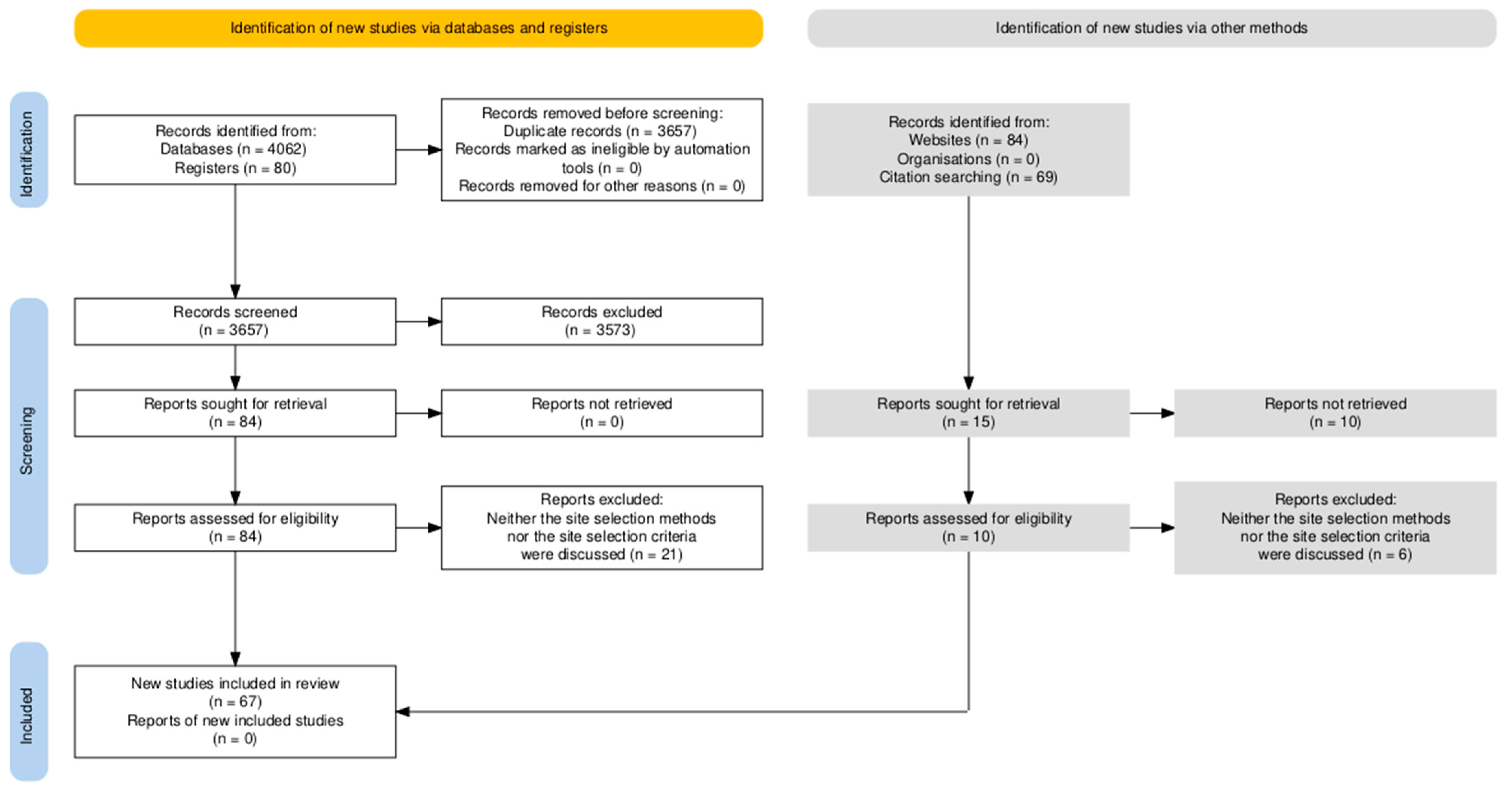
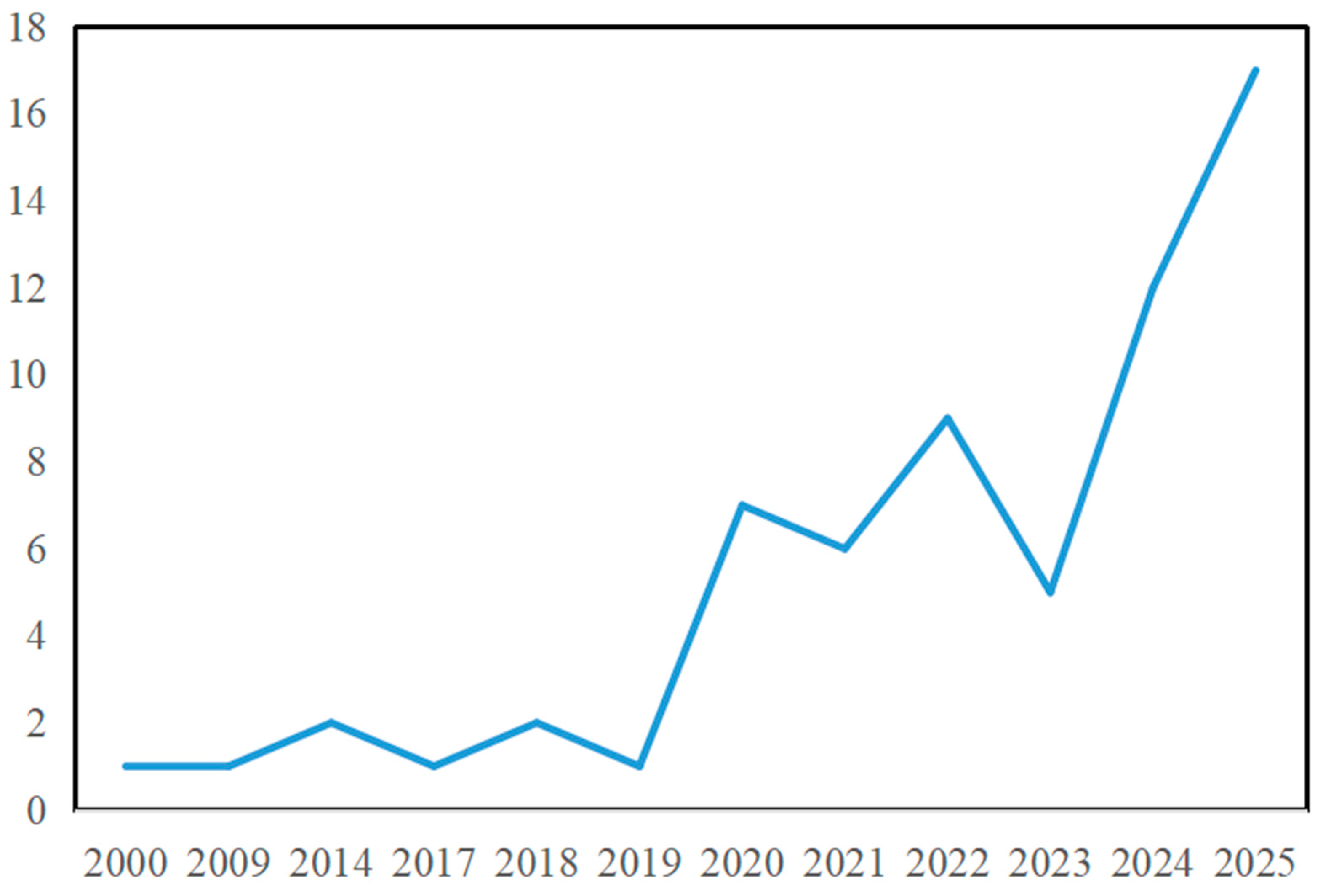
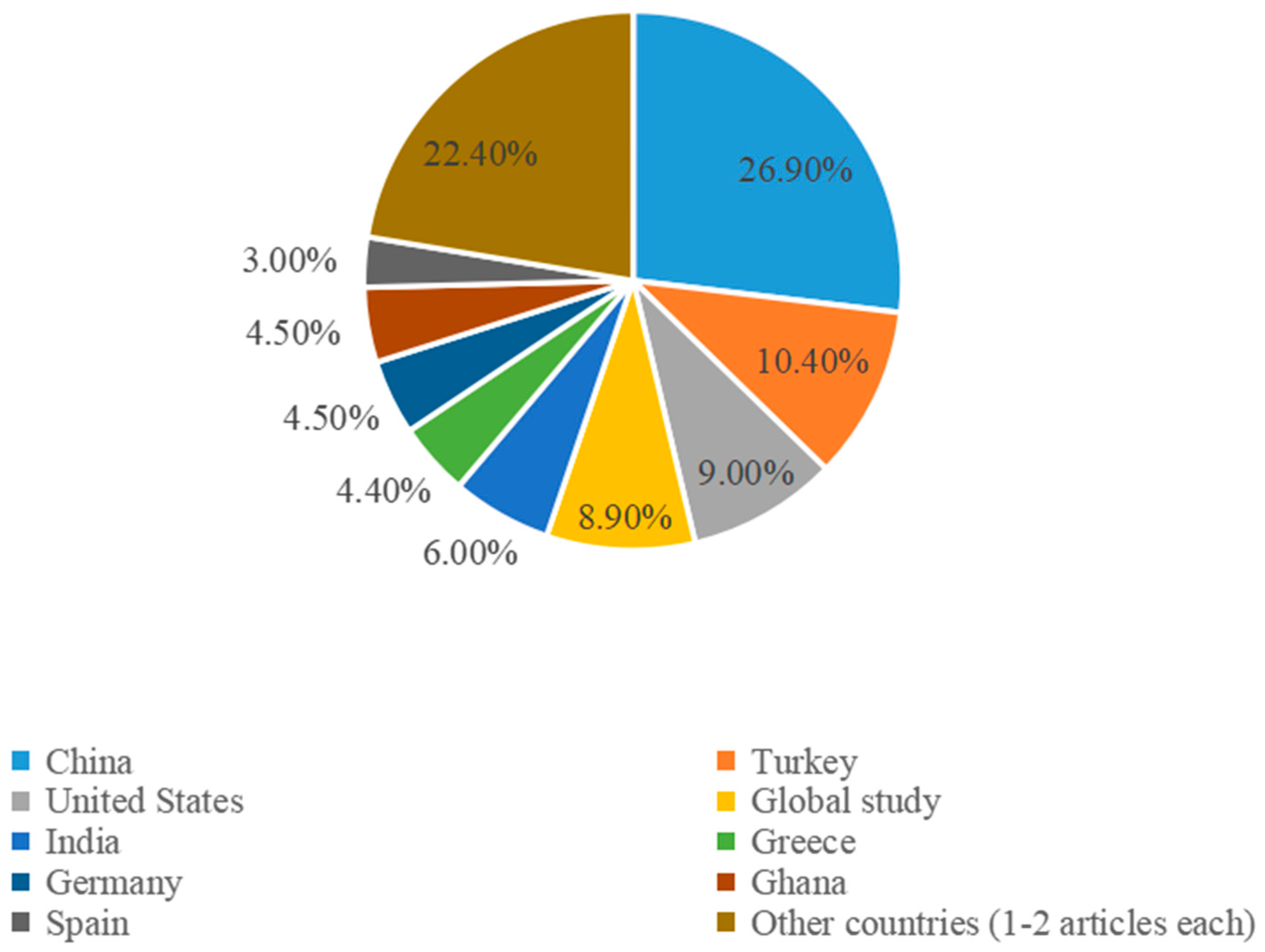
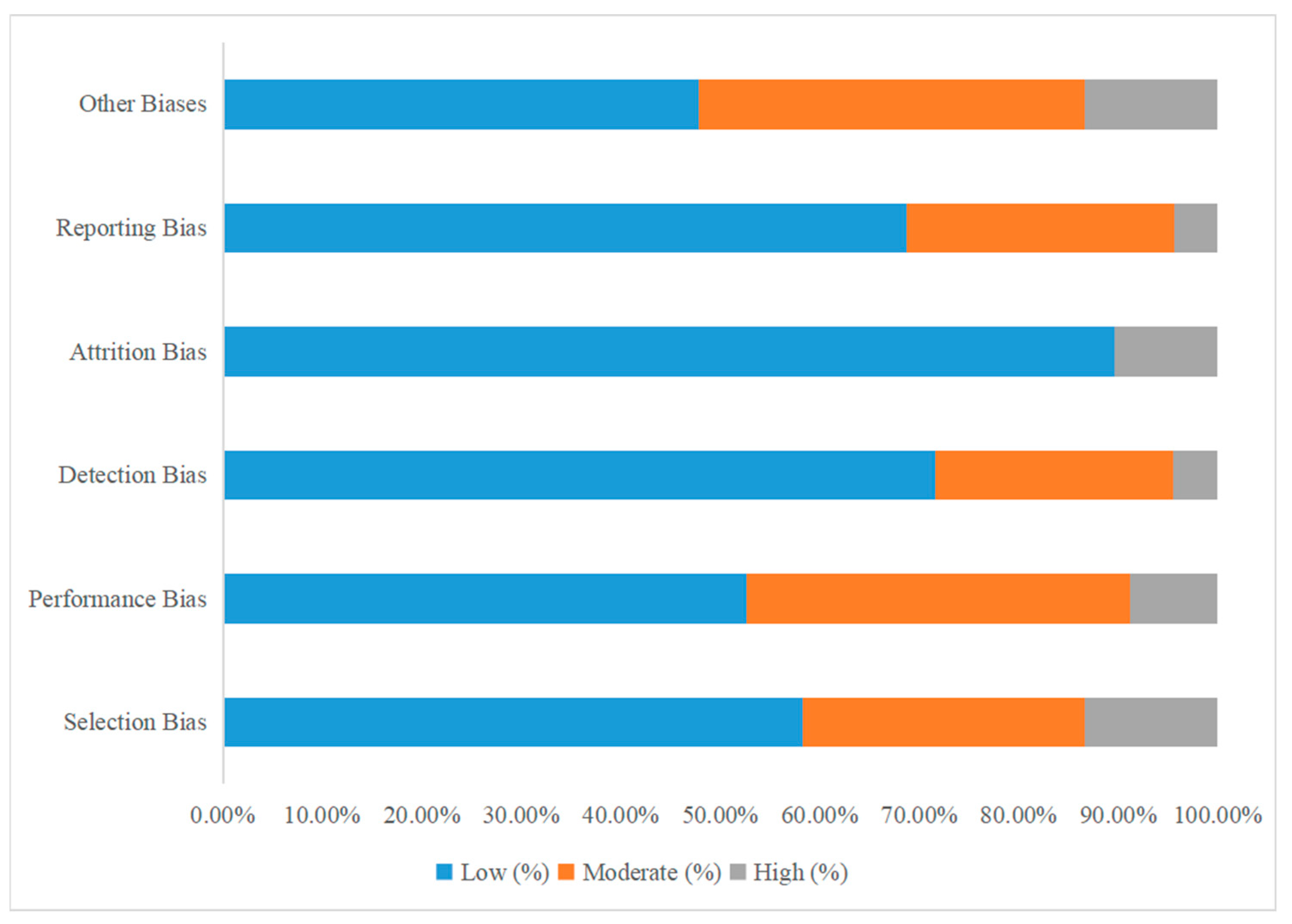
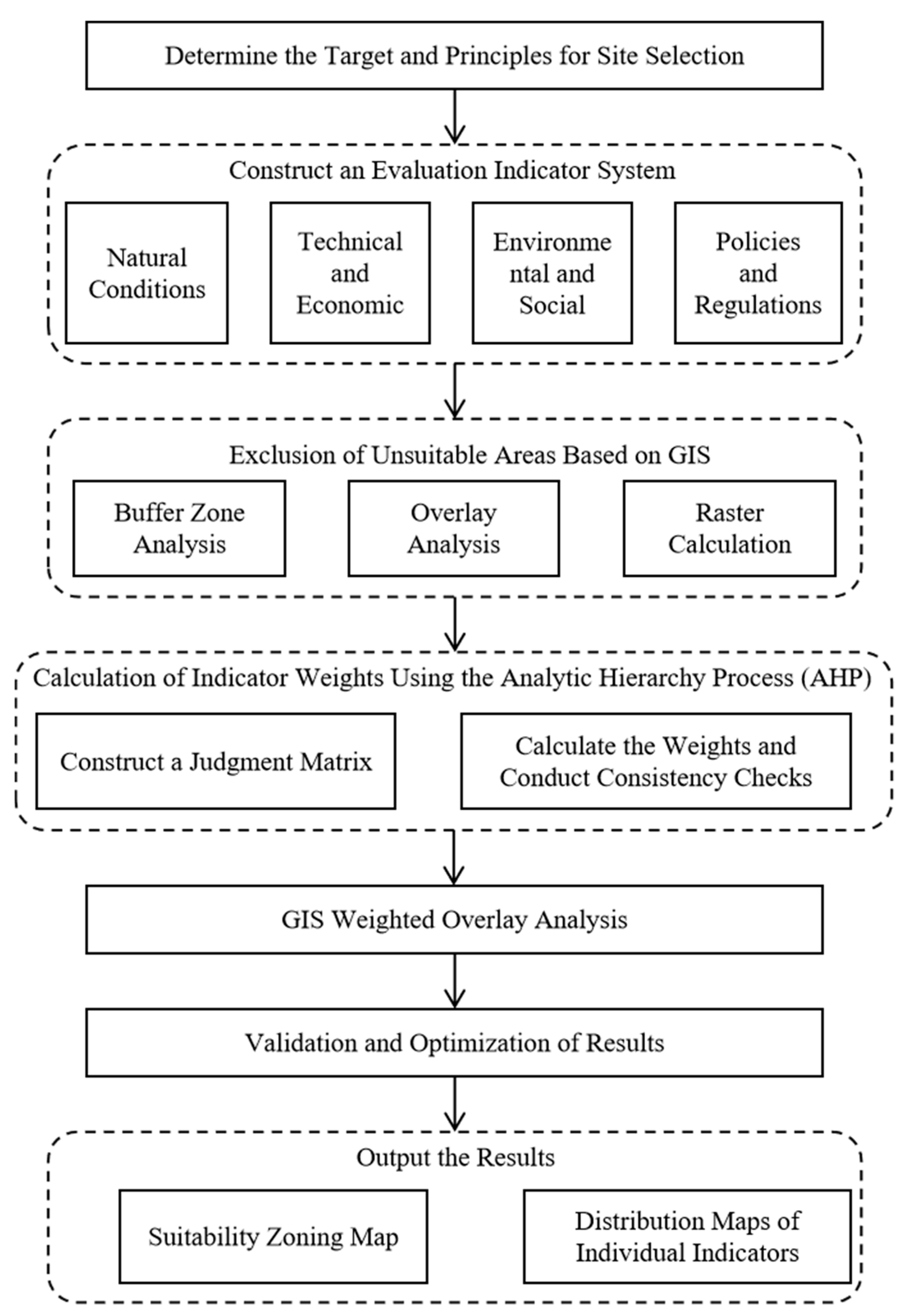
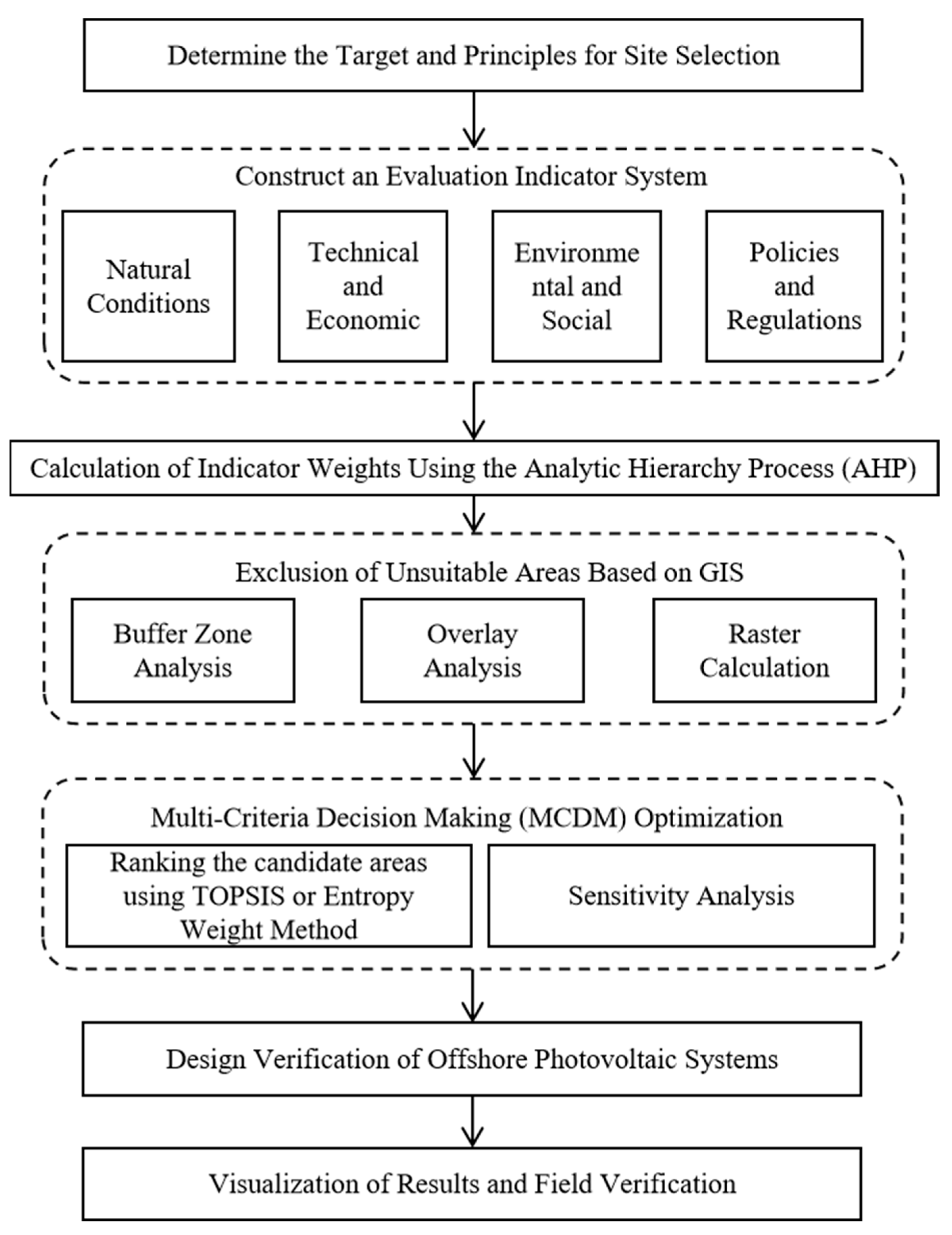
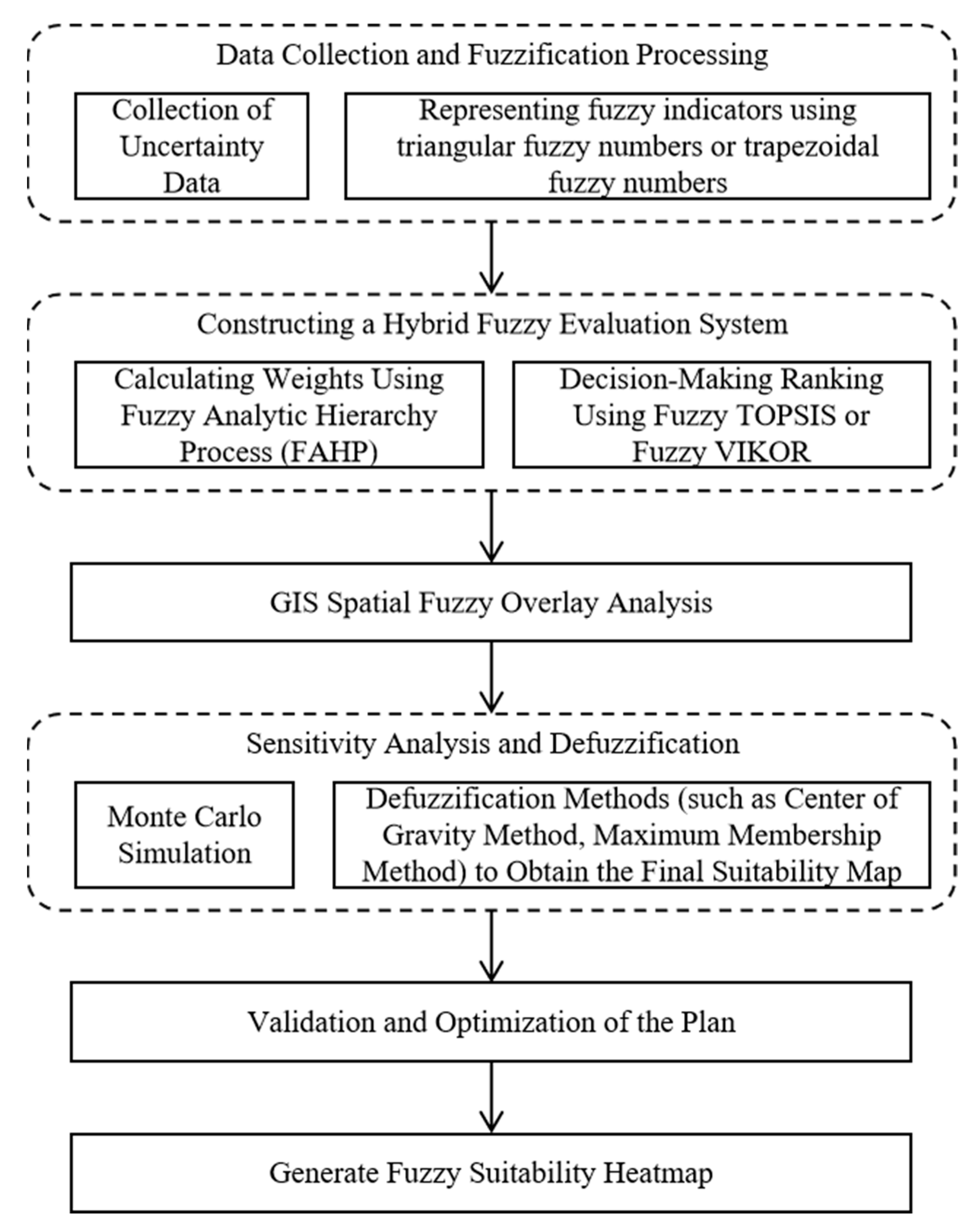

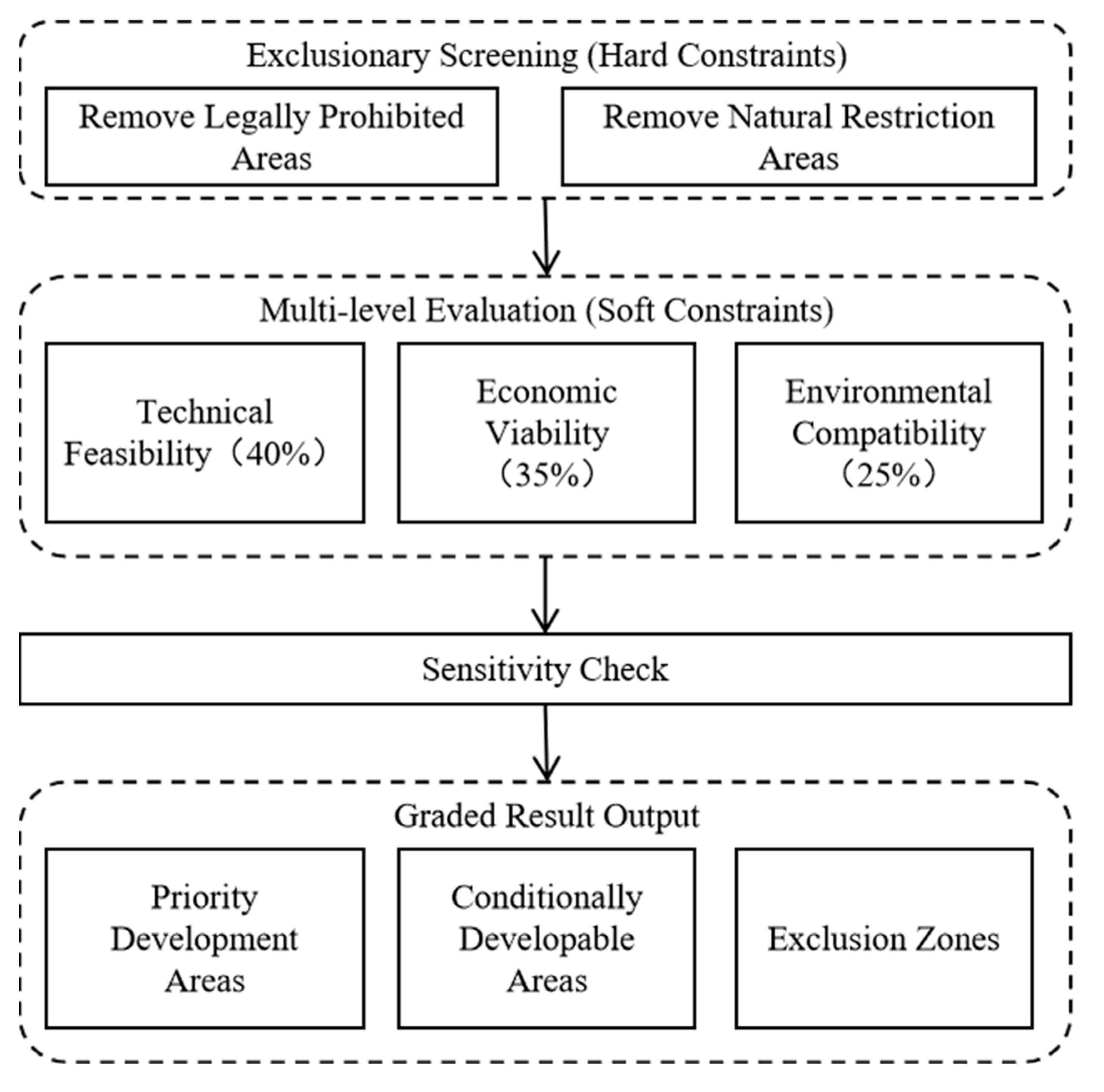
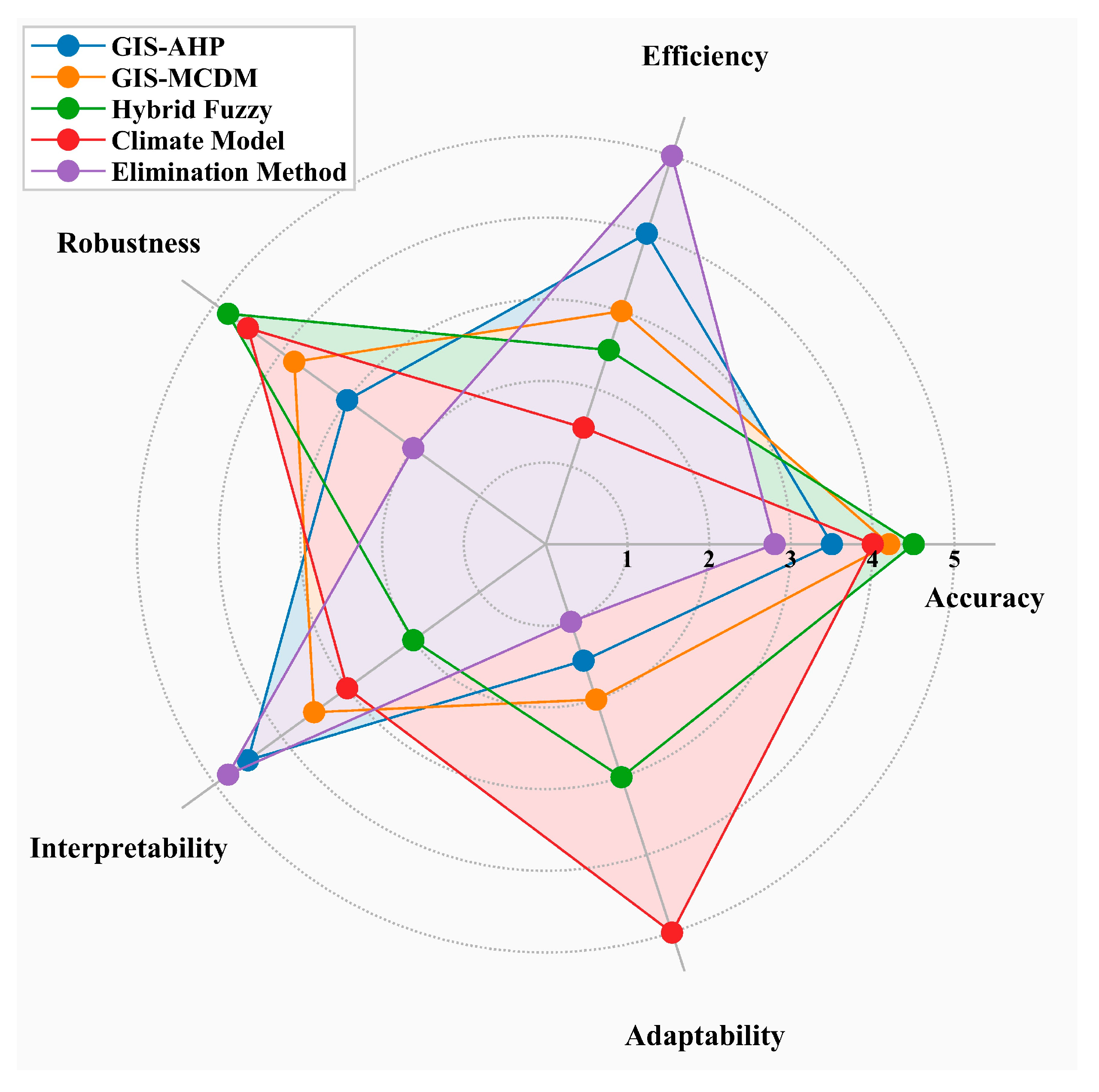
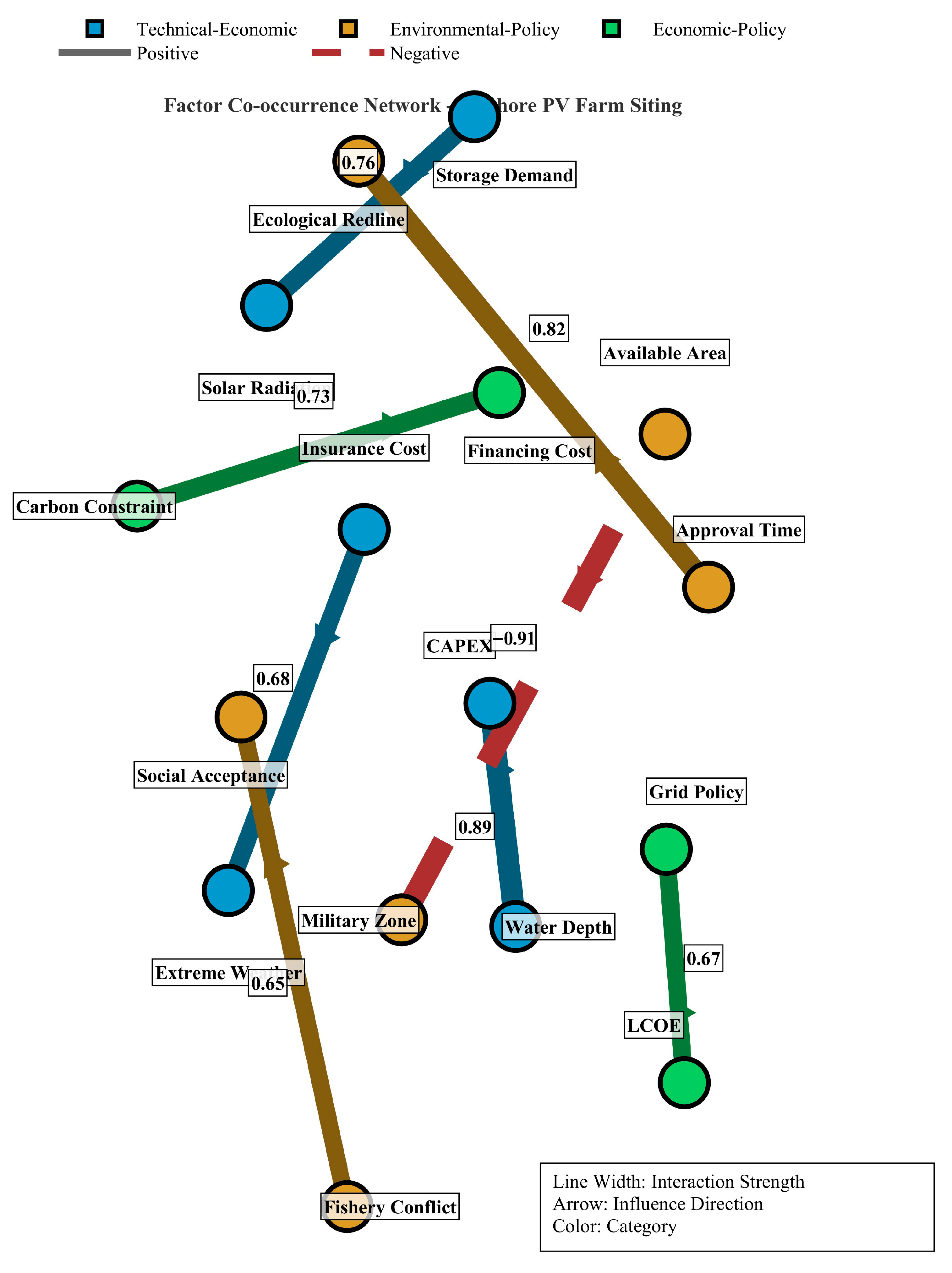
| Method Category | Percentage | Typical Application Cases |
|---|---|---|
| GIS-AHP | 41.80% | Large-scale PV projects in Saudi Arabia, Turkey, Spain [27,29] |
| GIS-MCDM | 32.80% | Complex environments in China, Turkey, Greece [5,16] |
| Hybrid Fuzzy Methods | 17.90% | High-uncertainty environments in Morocco [33] |
| Climate Model Analysis | 4.50% | Long-term planning in Eastern China, EU [7] |
| Exclusion-Evaluation Method | 3.00% | Rapid assessments in Mauritius, Egypt [36] |
| Other Methods | 4.50% | Emerging technologies like machine learning, digital twins [39] |
| Method Name | Advantages | Limitations | Offshore Suitability | References |
|---|---|---|---|---|
| GIS & Analytic Hierarchy Process (GIS-AHP) | Structured decision-making, supports multi-dimensional criteria (e.g., solar radiation, water depth); strong spatial visualization, well-established. | Subjective weight assignment (expert-dependent), static analysis struggles with dynamic changes (e.g., climate shifts). | Moderate-High Suitability, suitable for near-shore (<20 km) macro-site selection; requires marine environmental data. | [13] |
| GIS & Multi-Criteria Decision-Making (GIS-MCDM) | Flexible adaptation to different decision scenarios (e.g., TOPSIS/ELECTRE), high-precision grid analysis (e.g., 100 m × 100 m). | High data requirements, computational complexity, reduced efficiency with conflicting criteria. | High Suitability, ideal for complex marine areas (e.g., hybrid wind-PV projects). | [23] |
| Hybrid Fuzzy Methods | Effectively handles uncertainty (e.g., fuzzy linguistic variables), robust against outliers. | High implementation barrier (requires fuzzy mathematics expertise), poor interpretability. | High Suitability, suitable for deep-sea or extreme climate zones (e.g., typhoon-prone areas). | [43] |
| Climate Model-Based Long-Term Analysis | Forward-looking predictions (e.g., 30–50-year climate trends), mitigates long-term risks (e.g., sea-level rise). | Low resolution (>50 km), high computational cost, requires supercomputing. | Scenario-Specific Suitability, best for large-scale projects (>100 MW) and long-term planning. | [7,34] |
| Exclusion & Evaluation Criteria Method | Rapid screening of exclusion zones (e.g., shipping lanes, military areas), low computational cost. | Overly simplistic, ignores marginally suitable areas (e.g., low ecological impact zones). | Low Suitability, only for preliminary screening; requires refined follow-up methods. | [6] |
Disclaimer/Publisher’s Note: The statements, opinions and data contained in all publications are solely those of the individual author(s) and contributor(s) and not of MDPI and/or the editor(s). MDPI and/or the editor(s) disclaim responsibility for any injury to people or property resulting from any ideas, methods, instructions or products referred to in the content. |
© 2025 by the authors. Licensee MDPI, Basel, Switzerland. This article is an open access article distributed under the terms and conditions of the Creative Commons Attribution (CC BY) license (https://creativecommons.org/licenses/by/4.0/).
Share and Cite
Feng, Z.; Chen, J.; Lv, D.; Wang, P.; Zheng, K.; Guo, Z.; Yue, X. Research on Offshore Photovoltaic Project Site Selection Based on PRISMA: A Systematic Review. Sustainability 2025, 17, 8293. https://doi.org/10.3390/su17188293
Feng Z, Chen J, Lv D, Wang P, Zheng K, Guo Z, Yue X. Research on Offshore Photovoltaic Project Site Selection Based on PRISMA: A Systematic Review. Sustainability. 2025; 17(18):8293. https://doi.org/10.3390/su17188293
Chicago/Turabian StyleFeng, Zhenzhou, Jijing Chen, Duian Lv, Peng Wang, Kaixuan Zheng, Ziyan Guo, and Xihe Yue. 2025. "Research on Offshore Photovoltaic Project Site Selection Based on PRISMA: A Systematic Review" Sustainability 17, no. 18: 8293. https://doi.org/10.3390/su17188293
APA StyleFeng, Z., Chen, J., Lv, D., Wang, P., Zheng, K., Guo, Z., & Yue, X. (2025). Research on Offshore Photovoltaic Project Site Selection Based on PRISMA: A Systematic Review. Sustainability, 17(18), 8293. https://doi.org/10.3390/su17188293







